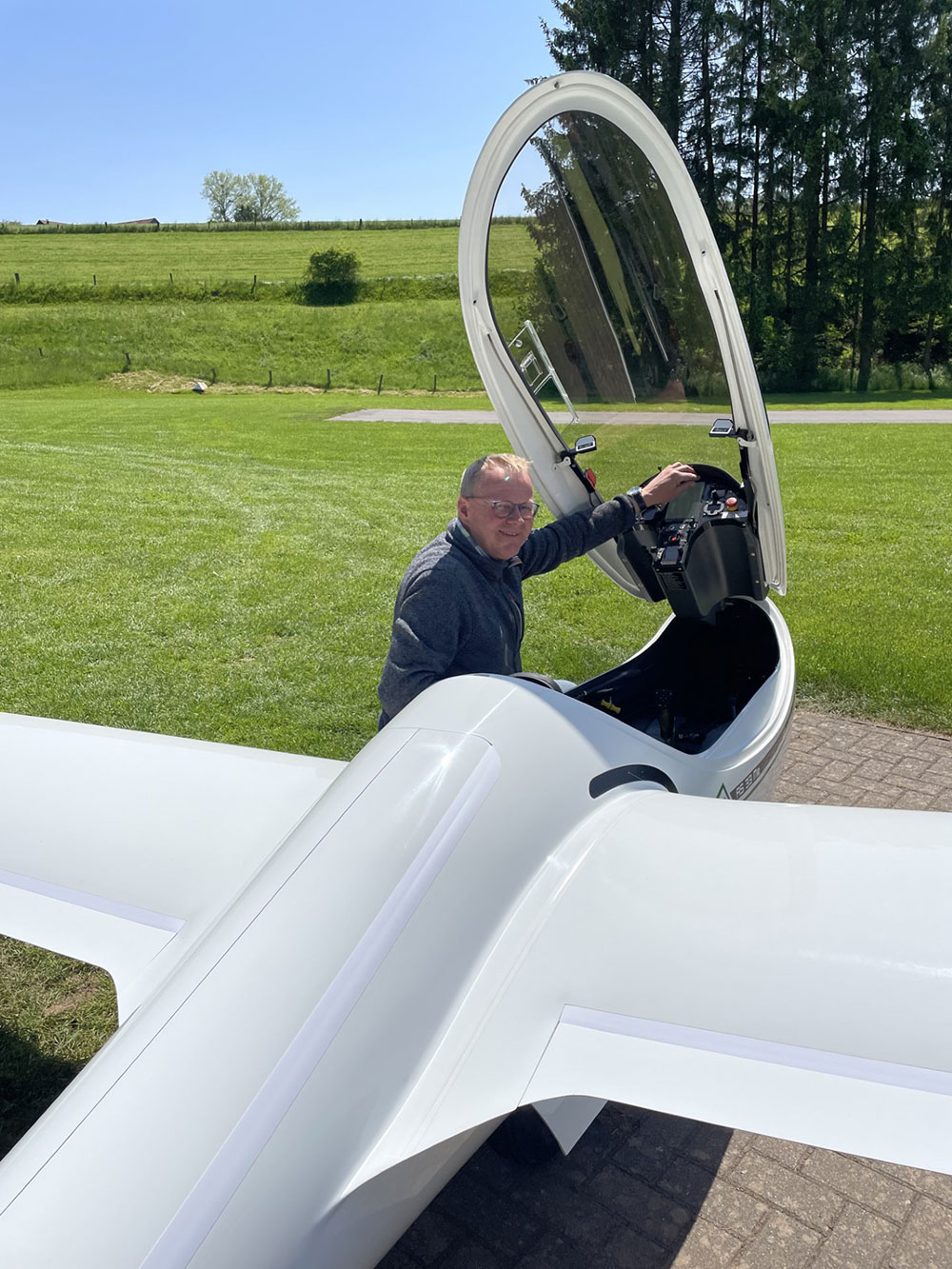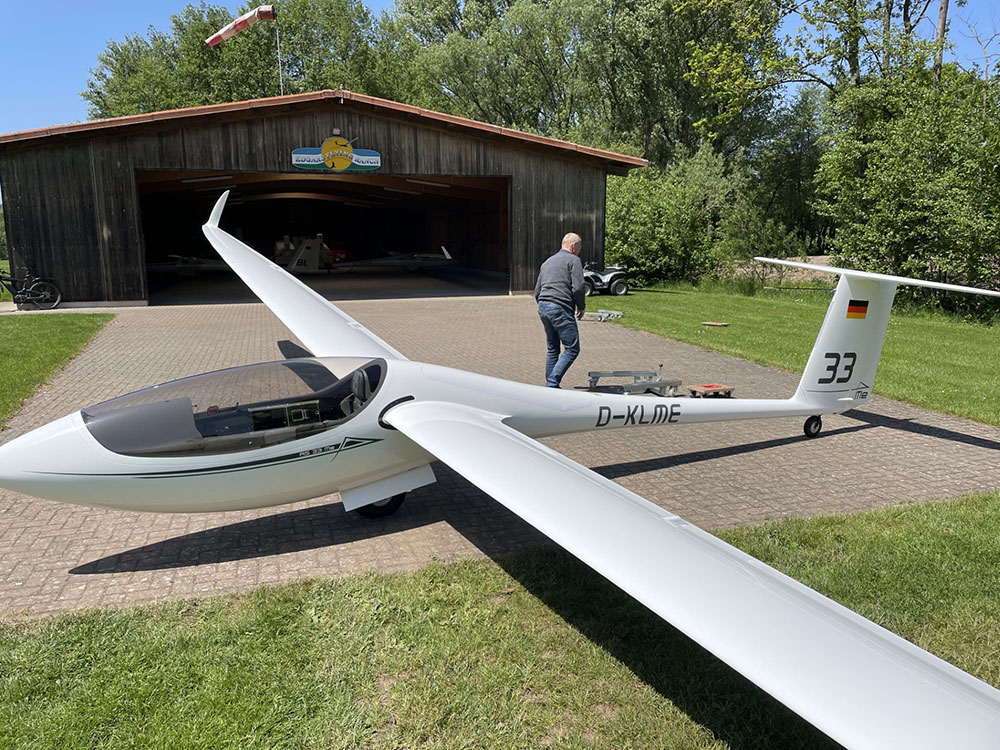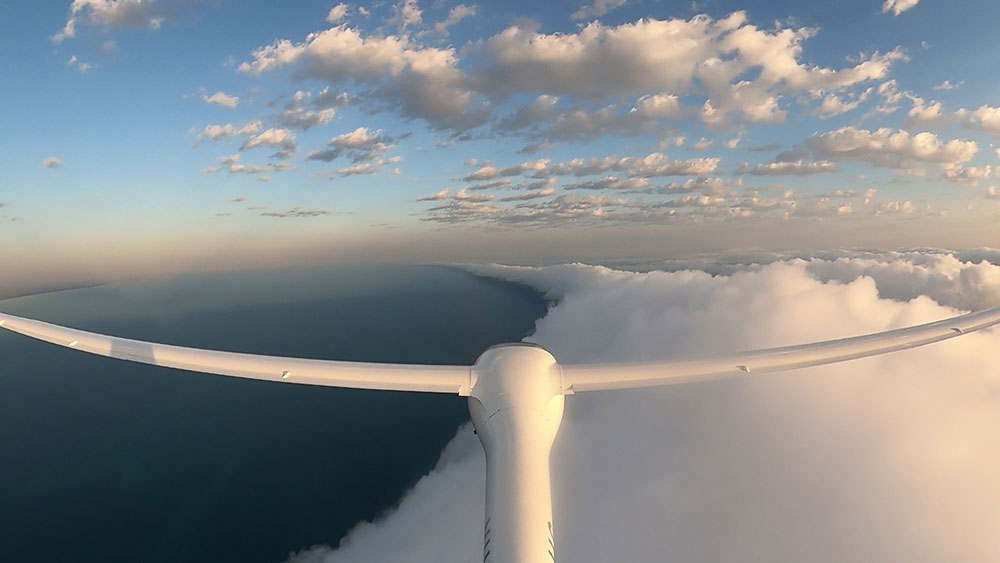
by Bernard Eckey
Australian agent for Alexander Schleicher GMBH
Some readers might recall my report after flying Schleicher’s unflapped electric self-launching AS 34 Me during a trip to Germany last year. This year I was faced with an equally exciting task. Yes, you guessed it, I had to fly the AS 33, not the petrol-powered sustainer version but the prototype of their very latest creation, the flapped self-launching fully electric AS 33 Me.
Being an agent for a German glider manufacturer can present unexpected challenges. Did I hear you say that I have got to be joking? Well, it started with my drive to the factory. Thick morning fog turned the usual 2½ hour drive into a dangerous trip lasting almost four hours. Luckily the driving conditions improved the closer I got to the town of Poppenhausen, the home of the Schleicher factory. On arrival I went straight to the production line to take photos of gliders for customers in my area of responsibility. By around lunch time, the sun had already burned big holes into the low clouds.
Plenty of Power
By early afternoon the sky had turned blue, at least in the vicinity of the little factory airstrip, which only tolerates take-offs in one direction and landings in the other. Thankfully, none other than Uli Kremer, the Schleicher MD, was on hand to get me into the air. He was proud that the AS 33 Me received its EASA type certificate before the second aircraft went into production.
While we pushed the AS 33 Me from the hangar onto the narrow runway, I commented on the stiff tail wind on take-off. “Don’t worry about it Bernard,” Uli said, “You have plenty of power at your disposal and you can even commence your take off run with the flaps in thermalling position. You will have aileron control right away and, if you keep some back pressure on the stick, you can wait for the aircraft to lift off by itself.”
I did as I was advised and found myself airborne much quicker than expected. That’s because of the flaps, I thought, and figured that they provide a little more lift compared to the wing of the Standard Class AS 34 Me. Also, the rate of climb seemed to be at least as good as the AS 34 despite the AS 33’s comparatively tiny wing of only 10 m2. After a minute or so I felt comfortable enough to reduce the 35 kW take off power to around 25 kW which maintained a climb rate of around 5kts.

Tough Climb
The air was very rough and I thought that the lower power setting would make it easier to feel the air and find a thermal. But that was wishful thinking. All I found was severe turbulence in the blue and, with the motor still running, I was in and out of lift all the time. Perhaps I should turn it off, I thought, and promptly moved the throttle lever all the way to the bottom stop. The propeller stopped immediately and a quick glance in the rear-view mirror confirmed that it automatically moved into a vertical position for retraction. Then it disappeared from view followed by the unmistakable ‘clonk’ sound indicating that it was properly stowed in its box again.
This didn’t make climbing any easier and presented the second challenge of the day. It was very frustrating indeed! Any promising gust was straight away followed by sink. Without the agility of the AS 33, it would have been difficult to climb at all. Hoping that it would get better, I rallied all the patience I could master. Yes, I was slowly climbing but well before getting to 3,000ft AGL, a darker layer of air indicated a solid inversion.
Several attempts to find a higher, more organised thermal failed and made me think of landing again. But then I spotted the first sign of a cumulus cloud on the horizon, which was estimated to be around 40km away and about 1,000ft higher. OK, I thought, there might be tricky outlanding terrain below, but I have the best performing 18m glider under my bum and I also have a very reliable electric power plant on board.
Air Start
Before making a bee line for the cumulus cloud I figured that it would be a good idea to practice an air start. When the throttle lever was moved to the first indent, a humming noise confirmed that the propeller was coming up. As soon as it was fully extended, the throttle was moved into the power range and the beast came alive without delay. All power plants should be as easy to operate as this, I thought, and then turned the motor off again. Afterwards, I repeated the entire procedure once more, just for the fun of it.
With the air start practice under my belt, I pointed the nose towards the cloud on the horizon. A few haze domes on track became welcome stepping stones and helped me to get there with ease. The lift proved not only a lot smoother but also stronger, which finally made for quite relaxed flying. Thermalling the AS 33 Me at around 55kts with my wing loading of 50kg/m2 felt quite comfortable now and the agility can only be described as superb. The airflow noise is the lowest I have ever encountered, probably due to newly developed canopy seals, which eliminate the escape of cockpit air into the ambient airstream.
Handling Characteristics
Equally remarkable are the glider’s pleasant handling characteristics with well coordinated controls. Obviously, the design team has pulled another rabbit out of their hats and developed a new wing section capable of handling high to very high wing loadings with ease. There isn’t any doubt in my mind that even at the maximum wing loading of 60 kg/m2 the AS 33 can comfortably be thermalled at 60 kts.
By now I had already been airborne for well over an hour and it was time to find out what this aircraft is capable of. Think positive with the flaps in negative was my motto from here onward, with the day’s earlier weather challenges not yet forgotten. At long last, the bird was in its element and it became obvious that it loves to be flown fast. After all, that is exactly what the design team was aiming for and what the polar curve indicates.
With wisps of clouds now only 5 or 6 km apart it was simply a matter of slowing down under them to retain my 4,000ft cruising altitude. The retractable tailwheel and the smallest wing area in 18m Class obviously gives the AS 33 the lowest amount of drag, and even as an Open Class pilot I thought that the resulting glide performance was nothing short of stunning. One can be forgiven for thinking that an angel is pushing from behind. Now I was thoroughly enjoying myself and wondering what it would be like to fly it at 60kg/m2.
Flap Settings
No stopping for lift made the countryside go past very quickly indeed. It was time to try out the bottom end of the speed range to find out what effect the high wing loading has on the bird’s stalling behaviour. After selecting neutral flaps the stick was slowly but steadily pulled back until it hit the stop. The nose came up and it got very quiet in the cockpit. With the stick still hard against the back stop the nose came down gently and the aircraft resumed safe flying speed.
So far so good I thought, but is it the same with positive and negative flap settings? In a word, the same procedure resulted in almost exactly the same outcome. Stalling at a medium bank angle and a slightly excessive rudder input was tried out next. Yes, this made the inner wing drop but in a docile and easily manageable manner. Relaxing the back pressure on the stick was enough to bring the situation under control again.
With all that mucking around I had lost enough height to drop well below glide to the factory strip. Another thermal was needed but now I was under a blue sky. Luckily I met up with the pilot of the AS 34 Me factory demonstrator who must have launched some time after me. We briefly climbed together, and when I realised that I’ve been airborne for almost four hours I radioed Uli with my intention to land. He promptly hopped on his pushbike for a dash to the airstrip and helped me put the AS 33 Me back in the hangar.
Electric Investment
After he connected the battery charger, we discussed the advantages of electric propulsion systems and the rapid acceptance of this technology by the worldwide gliding community. We agreed that it has every potential to revive our sport and I congratulated Uli for recognising this and for investing heavily to cement Schleicher’s leading electric self-launch position.
The AS 34 Me came in to land and, after it was also put to bed, Uli’s long working day came to an end. However, he still took the time to update me on Schleicher’s latest developments and product refinements. We also talked about the AS 35 Mi, the new Open Class glider – I might tell you more about it some other time. It is very pleasing to know that Schleicher is clearly not resting on its laurels!
The only thing left for me to do was to say “Thank you” and drive back to my brother’s granny flat. Unfortunately, I met with bad luck once again and got stuck in a traffic jam on the German Autobahn for several hours - so much for high speed Autobahn driving. Hence, being the agent of a German glider manufacturer can have its challenging moments but it also comes with the privilege of flying the latest and greatest when you are on your annual pilgrimage to Germany.
































